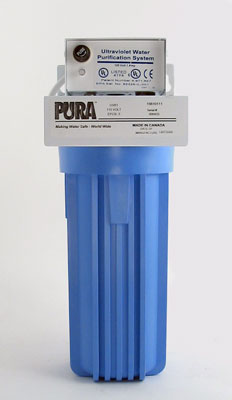Hotter Isn’t Necessarily Better When It Comes To UV Output
Most ultraviolet systems that are used to disinfect water flowing at less than 40 gallons per minute use what are called “low-pressure” UV lamps. These lamps contain a small amount of mercury, which vaporizes when current flows through the lamp, producing what is considered the ideal “germicidal” UV wavelength of 254 nanometers.
The ideal dosage of 254 nanometers, however, is dependent on some variables, and not the least of these is  temperature.
temperature.
UV designers speak of the “cold spot” on the lamp. That is the coolest section on the lamp surface. The “cold spot” should be at about 108 degrees (42 C.) for the UV unit to operate at the optimal 254 nanometers. As the temperature of the lamp changes, so does the dosage from the lamp.
In standard residential UV units the germicidal lamp is enclosed in a transparent tube called a quartz sleeve. The sleeve is immersed in water. It surrounds the lamp and protects it from exposure to water. Although water does not touch the lamp, the temperature of the water affects the lamp temperature since it cools the air between the sleeve and the lamp. A change in water temperature, therefore, can have a dramatic effect on the temperature of the lamp itself and consequently on the performance of the UV unit.
How Temperature Affects UV Output
There is an assumption that the higher the temperature within the UV treatment chamber, the greater the effectiveness of the UV unit at disarming pathogens. Not so. In fact, varying in either direction from the ideal cold spot temperature results in diminished performance. Cold water can lower the cold-spot temperature so that the UV output will drop as much as 50 percent below its maximum. Hot water around the quartz sleeve will also lower the UV output by as much as 50 percent. Ideal water temperature for operating a UV unit with the lamp inside a quartz sleeve is about 22 C (71 F).
One factor that is seldom considered in UV planning is that water standing in the UV treatment chamber can become very hot. In undersink UV units, the elevated temperature can send aesthetically unpleasing tepid water out of the spigot, but what is worse, elevated heat can also reduce the efficiency of the UV lamp. This could be a problem if a long period of inactivity is followed by a period of high flow rate.
Some modern UV manufacturers, like Viqua, offer an optional solenoid-controlled feature that moves water through the system periodically to prevent heat build-up.




